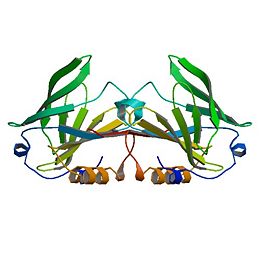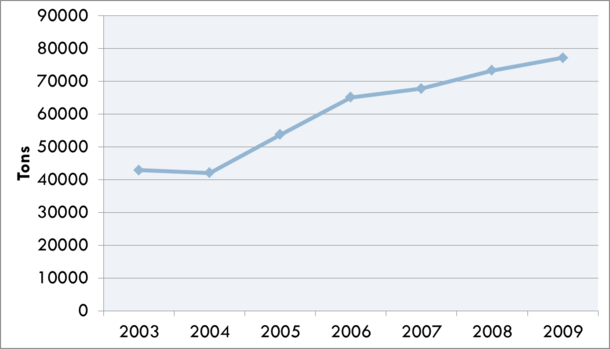From Proteopedia
(Difference between revisions)
proteopedia linkproteopedia link
|
|
| Line 28: |
Line 28: |
| | <StructureSection load='1bso' size='280' side='right' caption='Structure of Beta Lactoglobulin with 12-BROMODODECANOIC ACID (PDB entry [[1bso]])' scene=''> | | <StructureSection load='1bso' size='280' side='right' caption='Structure of Beta Lactoglobulin with 12-BROMODODECANOIC ACID (PDB entry [[1bso]])' scene=''> |
| | | | |
| - | No definite physiological function has been ascribed to β-LG, although several suggestions have been made, the more compelling of which favor a role in molecular transport or, possibly, as some form of modulator (Kontopidis et al., 2002). Most suggestions concerning the function, understandably, have concentrated on either the lactating cell or more usually the neonate, and a transporter role seems reasonable, since many lipocalins are transporters. β-Lactoglobulin binds both fatty acids and retinol, and the structure is similar to the known transporter, plasma RBP. The nature of the ligand transported, apart from being generally hydrophobic, is not clear, however. Fatty acids, rather than retinal, are found as endogenous ligands in milk, but not all species have a β-LG that binds fatty acids (Perez et al., 1989, 1993), and it seems improbable that the true function will vary from species to species. Similarly, retinol is significantly more soluble in the fat phase of milk and thus will probably be transferred from mother to offspring by that route. A signaling or activity-modulator role appears to be less likely, not just because of the paucity of similar roles reported for other lipocalins (Flower et al., 2000), but also because the data supporting these various activities appear rather circumstantial. Further, for such an important role, one might expect the presence of β-LG in the milks of all species, not just some. What does not appear to have been considered in detail until recently (Kontopidis et al., 2002) is that the function is directly related to maternal physiology.
| + | While no definite physiological function has been attributed to β-LG, several possibilities do exist. As a lipocalin it only stands to reason that most suggestions involve a role in molecular transport of small hydrophobic ligand transport (Kontopidis et al., 2002). Most research concentrates on the lactating cell or the neonate. β-Lactoglobulin does bind to fatty acids of intermediate to long length and retinol. It is very similar in structure to plasma retinol binding protein. Genetic variation does throw some doubt on these suggestions however, as β-Lactoglobulin in some species do not bind with fatty acids (Perez et al., 1989, 1993). This would suggest that its main function is in fact, not as a fatty acid transporter. It also seems unnecessary as a retinol binding transporting seeing as retinol associates more strongly with the fat in milk and does not depend on β-LG as its primary transporter. Data on β-LG’s role as an activity-modulator tends to be circumstantial. It has been suggested that the function of β-LG is directly related to maternal physiology (Kontopidis et al., 2002). |
| | + | Nutritional value seems to be a valid purpose for β-LG. In the case of many species, the gene determining β-LG production has undergone a gene duplication and is involved more with nutrition than other functional purposes. Some species, like rodents, humans, and lagomorphs lost the ability to produce β-LG through formation of a pseudo-gene. While ligand binding and even the inhibition of harmful bacterial adhesion in the intestine (Ouwehand et al., 1997) are certainly useful properties, but neonatal nutrition continues to be the primary function. |
| | | | |
| - | When the species variation of β-LG sequences is examined along with that of the other lipocalins, what emerges is a family tree like that shown in Figure 4. The RBP are clearly distinct from the lactoglobulins, but there is one protein present in the endometrium, now called glycodelin (formerly PP14, inter alia), that is the closest relative to the β-LG-II gene product (Halttunen et al., 2000; Seppälä, 2002). There are also reports of RBP expressed in the endometrium of cow (Thomas et al., 1992; MacKenzie et al., 1997). Notice also that there is ruminant pseudo-gene identified in both cow and goat that is also most nearly related to the sequence of β-LG-II. Might it be that the protein glycodelin reflects the true, original function of β-LG as a protein involved in some aspect of fetal development in all mammals? In many species, the gene has undergone a gene duplication event and is expressed during lactation for nutritional purposes. More recently, some species, like rodents, lagomorphs, and man, have lost the function of one of these genes through formation of a pseudo-gene, resulting in the gene ceasing to be expressed. The biological properties of the milk protein, such as ligand binding and inhibiting harmful bacterial adhesion in the intestine (Ouwehand et al., 1997) that have been identified, are clearly useful to each species but are subsidiary to those of neonatal nutrition. On the other hand, it is known that low levels of β-LG are expressed in the cow throughout the dry period in a manner that is distinct from α-LA and the caseins (Aslam et al., 1994). Whether this is indicative of another more physiological role for β-LG in the changes that occur to the mammary gland during this period remains unclear at present. | |
| | | | |
| | </StructureSection> | | </StructureSection> |
Revision as of 16:14, 27 November 2012
Beta Lactoglobulin
β-Lactoglobulin(β-LG) is the bulk constituent of whey protein in most ruminant species and is also present in the milks of most mammalian species, although not in rodent, human, and lagomorph milks. It has been studied extensively for some time ( Tilley, 1960; Lyster, 1972; Kinsella and Whitehead, 1987; Hambling et al., 1992; Sawyer, 2003). β-LG is a lipocalin as is seen through its amino-acid sequence and structure (Flower et al., 2000). Lipocalins are a varied family which bind small hydrophobic ligands, and often act as transporters in vivo. The purpose of β-LG, however, is not clear. Genetic variants of β-LG expressing genes have been reported, especially in cows and several nonruminant species (Kontopidis, 2004).
Whey is an often used food ingredient in the food industry and has many useful functional characteristics including foaming, gelling, thermal stability, emulsification, and protein fortification. It has also been suggested that it has many useful health benefits including exercise recovery, weight management, cardiovascular health, anti-cancer effects, anti-infection activity, wound repair, and infant nutrition.
Human consumption of whey ingredients has steadily increased and has become more and more important to the dairy industry.
An issue with whey ingredients is the subtle off flavor often associated with whey proteins. During the
Cheddar cheese making process, norbixin leaches into the whey during the draining of the curd. Norbixin, a carotenoid extracted from the bixa orellana seed and added to cheese milk to give Cheddar its expected yellow flavor, would also contribute yellow color to the final product into which the whey ingredient is added. To prevent discoloration of the final product, whey is bleached by either hydrogen peroxide or benzoyl peroxide. In addition to a white color, this also causes lipid oxidation and associated off flavors.

Whey protein powder

Whey production process
| β-Lactoglobulin is a small protein with 162 amino acid residues (Mr ∼18,400). β-LG folds up into an 8-stranded, antiparallel β-barrel with a 3-turn α-helix on the outer surface and a ninth β-strand flanking the first strand. The ninth β-strand forms the dimer interface in cow and sheep proteins. The calyx, or β-barrel, is conical and serves as the ligand binding sight for small hydrophobic ligands. It is made of β-strands A-D forming one sheet, and strands E-H forming a second. Strand A turns at a right angle and the C-terminal end forms an antiparallel strand with H. A 3-turn helix between strands G and H is located on the outer surface of the β-barrel between strands G and H. The loops that connect the β-strands at the closed end of the calyx, BC, DE, and FG are generally quite short, whereas those at the open end are significantly longer and more flexible (Kontopidis, 2004). This becomes especially important when considering conformational changes at different pH values. Specifically, the EF loops can act as a “gate”, opening or closing access to and from the internal binding site. At acidic pH the “gate” closes while at neutral and basic pH values the “gate” is open, allowing for ligand binding at the hydrophobic binding site. The gate “hinge” is Glu89 (Kontopidis, 2004).
The free Cys121 has a reactive thiol group, whose activity parallels the pH dependency of the Tanford transition and is involved with the denaturation and aggregation of the system (Havea et al., 2001).. It is situated on the outer surfaced of the β-barrel and underneath the α-helix, which offers it some protection from the solvent and pH effects.
|
Physiological Function of β-LG
| |
While no definite physiological function has been attributed to β-LG, several possibilities do exist. As a lipocalin it only stands to reason that most suggestions involve a role in molecular transport of small hydrophobic ligand transport (Kontopidis et al., 2002). Most research concentrates on the lactating cell or the neonate. β-Lactoglobulin does bind to fatty acids of intermediate to long length and retinol. It is very similar in structure to plasma retinol binding protein. Genetic variation does throw some doubt on these suggestions however, as β-Lactoglobulin in some species do not bind with fatty acids (Perez et al., 1989, 1993). This would suggest that its main function is in fact, not as a fatty acid transporter. It also seems unnecessary as a retinol binding transporting seeing as retinol associates more strongly with the fat in milk and does not depend on β-LG as its primary transporter. Data on β-LG’s role as an activity-modulator tends to be circumstantial. It has been suggested that the function of β-LG is directly related to maternal physiology (Kontopidis et al., 2002).
Nutritional value seems to be a valid purpose for β-LG. In the case of many species, the gene determining β-LG production has undergone a gene duplication and is involved more with nutrition than other functional purposes. Some species, like rodents, humans, and lagomorphs lost the ability to produce β-LG through formation of a pseudo-gene. While ligand binding and even the inhibition of harmful bacterial adhesion in the intestine (Ouwehand et al., 1997) are certainly useful properties, but neonatal nutrition continues to be the primary function.
|
|
Tanford Transition of β-LG
| | |
he structures of the trigonal crystal form of bovine beta-lactoglobulin variant A at pH 6.2, 7.1, and 8.2 have been determined by X-ray diffraction methods at a resolution of 2.56, 2. 24, and 2.49 A, respectively. The corresponding values for R (Rfree) are 0.192 (0.240), 0.234 (0.279), and 0.232 (0.277). The C and N termini as well as two disulfide bonds are clearly defined in these models. The glutamate side chain of residue 89 is buried at pH 6.2 and becomes exposed at pH 7.1 and 8.2. This conformational change, involving the loop 85-90, provides a structural basis for a variety of pH-dependent chemical, physical, and spectroscopic phenomena, collectively known as the Tanford transition. The structures of the trigonal crystal form of bovine beta-lactoglobulin variant A at pH 6.2, 7.1, and 8.2 have been determined by X-ray diffraction methods at a resolution of 2.56, 2. 24, and 2.49 A, respectively. The corresponding values for R (Rfree) are 0.192 (0.240), 0.234 (0.279), and 0.232 (0.277). The C and N termini as well as two disulfide bonds are clearly defined in these models. The glutamate side chain of residue 89 is buried at pH 6.2 and becomes exposed at pH 7.1 and 8.2. This conformational change, involving the loop 85-90, provides a structural basis for a variety of pH-dependent chemical, physical, and spectroscopic phenomena, collectively known as the Tanford transition.
|
|
|




